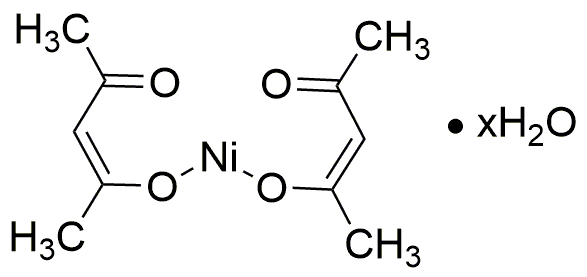Bis(2,4-pentanedionato)nickel(II) hydrate is widely utilized in research focused on:
- Catalysis: This compound serves as an effective catalyst in various organic reactions, enhancing reaction rates and selectivity, which is crucial in the production of fine chemicals.
- Electrochemistry: It is used in the development of nickel-based electrodes for batteries and supercapacitors, improving energy storage solutions in the renewable energy sector.
- Magnetic Materials: The compound is applied in the synthesis of magnetic nanoparticles, which are valuable in data storage, medical imaging, and targeted drug delivery systems.
- Coatings: It is incorporated into protective coatings to enhance corrosion resistance in industrial applications, particularly in the automotive and aerospace industries.
- Research and Development: The compound is a key reagent in the synthesis of novel nickel complexes, facilitating advancements in materials science and coordination chemistry.
General Information
Properties
Safety and Regulations
Applications
Bis(2,4-pentanedionato)nickel(II) hydrate is widely utilized in research focused on:
- Catalysis: This compound serves as an effective catalyst in various organic reactions, enhancing reaction rates and selectivity, which is crucial in the production of fine chemicals.
- Electrochemistry: It is used in the development of nickel-based electrodes for batteries and supercapacitors, improving energy storage solutions in the renewable energy sector.
- Magnetic Materials: The compound is applied in the synthesis of magnetic nanoparticles, which are valuable in data storage, medical imaging, and targeted drug delivery systems.
- Coatings: It is incorporated into protective coatings to enhance corrosion resistance in industrial applications, particularly in the automotive and aerospace industries.
- Research and Development: The compound is a key reagent in the synthesis of novel nickel complexes, facilitating advancements in materials science and coordination chemistry.
Documents
Safety Data Sheets (SDS)
The SDS provides comprehensive safety information on handling, storage, and disposal of the product.
Product Specification (PS)
The PS provides a comprehensive breakdown of the product’s properties, including chemical composition, physical state, purity, and storage requirements. It also details acceptable quality ranges and the product's intended applications.
Certificates of Analysis (COA)
Search for Certificates of Analysis (COA) by entering the products Lot Number. Lot and Batch Numbers can be found on a product’s label following the words ‘Lot’ or ‘Batch’.
*Catalog Number
*Lot Number
Certificates Of Origin (COO)
This COO confirms the country where the product was manufactured, and also details the materials and components used in it and whether it is derived from natural, synthetic, or other specific sources. This certificate may be required for customs, trade, and regulatory compliance.
*Catalog Number
*Lot Number
Safety Data Sheets (SDS)
The SDS provides comprehensive safety information on handling, storage, and disposal of the product.
DownloadProduct Specification (PS)
The PS provides a comprehensive breakdown of the product’s properties, including chemical composition, physical state, purity, and storage requirements. It also details acceptable quality ranges and the product's intended applications.
DownloadCertificates of Analysis (COA)
Search for Certificates of Analysis (COA) by entering the products Lot Number. Lot and Batch Numbers can be found on a product’s label following the words ‘Lot’ or ‘Batch’.
*Catalog Number
*Lot Number
Certificates Of Origin (COO)
This COO confirms the country where the product was manufactured, and also details the materials and components used in it and whether it is derived from natural, synthetic, or other specific sources. This certificate may be required for customs, trade, and regulatory compliance.


